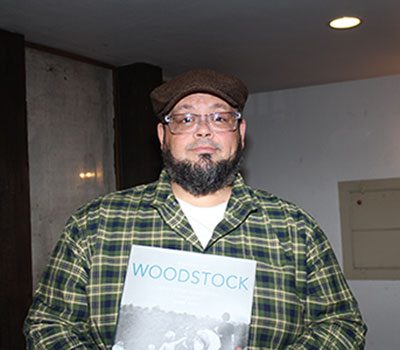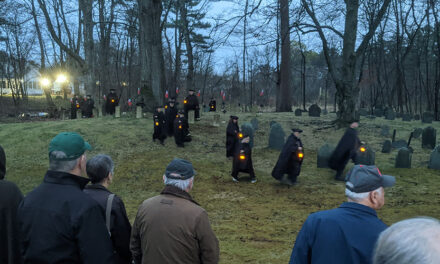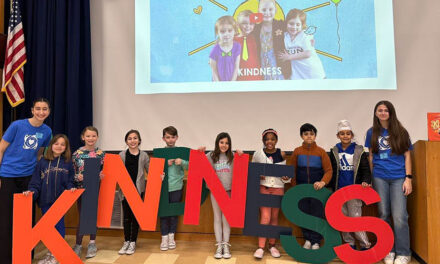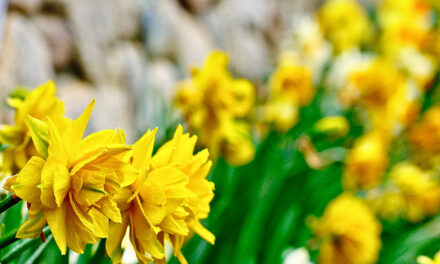Published September 26, 2019
By DAN TOMASELLO
LYNNFIELD — Woodstock was a music festival that defined a generation, author John Kane told a group of attendees during a Sept. 18 presentation at the Meeting House.
Kane is the author of the book “Pilgrims of Woodstock,” which chronicles the four-day festival in August 1969 that changed music and art forever. He said the book focuses on “the audience experience” at Woodstock.
“It’s about what it was like to be in that field for three or four days amid all of the adversities including the weather, drugs, counter-culture happenings, the lack of food and the lack of water,” said Kane.

AUTHOR JOHN KANE discussed his book “Pilgrims of Woodstock” during a presentation at the Meeting House on Sept. 18. (Dan Tomasello Photo)
In addition to interviewing the festival’s attendees, Kane said “Pilgrims of Woodstock” contains never-before-seen photos from late Brooklyn, New York photojournalist Richard F. Bellak.
“Bellak basically sat on this collection for all his life and they were never published,” said Kane. “Because of my work in the field about music from this era, friends of mine who are other scholars pointed me in this direction. I am now the curator of this collection.”
Kane said his interest in Woodstock developed when he was a teenager. He recalled renting classic concert movies “Cream: Farewell Concert” and Led Zeppelin’s “The Song Remains the Same” before renting the “Woodstock” documentary film.
“It contained two massive VHS cassette tapes,” said Kane. “I was hooked when I brought it home. When I popped those tapes in, I was amazed so many people could gather at one spot. The lineup of amazing music was so incredible.”
Kane recalled that, “The 1960s were among the most tumultuous and divisive decades in world history.”
“The 60s were marked by the Civil Rights Movement, the Vietnam War, anti-war protests, political assassinations and the emerging generation gap,” said Kane. “In the summer of 1969, the Stonewall Riots, Sen. Ted Kennedy and Chappaquiddick, the moon landing and the Manson murders all occurred before Woodstock. By the time Woodstock arrived, a heightened tension was felt around the country. Woodstock would help define that era.”
Kane said Artie Kornfield, Joel Rosenman, John P. Roberts and “the face of Woodstock” Michael Lang organized the legendary festival. He said Woodstock Ventures had trouble finding a venue to hold the festival, as the original plan of holding it in Wallkill, New York was rejected due to residents’ opposition. He said farmer Max Yasgur agreed to allow the festival’s organizers to host Woodstock on his dairy farm in Bethel, New York.
“By this time, they had already sold 100,000 tickets,” said Kane. “They had to move all of the production in and get the word out that they were moving. They didn’t have social media or the internet back then so it was a real challenge.”
According to Kane, Woodstock Ventures decided to stop selling tickets and agreed to allow attendees to enter the festival for free because they had to pull their remaining available resources into building the stage instead of finishing the festival’s ticket booths.
Kane recalled former Gov. Nelson Rockefeller (R-New York) signed into law a “mass gathering act” after Woodstock took place in August 1969.
“It meant that any gathering of over 5,000 people required health and safety permits,” said Kane. “If you had been following the details about Woodstock 50, you would learn that Michael Lang was having trouble finding and securing a location for the Woodstock 50 festival. Fifty years later, Michael Lang was fighting against the permits Woodstock 1969 created. It’s quite ironic.”
Kane said people came to Woodstock from all over the country and Canada. He said concertgoers traveled to the festival by cars, buses and even hitchhiked.
“You could write a book about how people got to Woodstock,” said Kane. “If you drove, you could only get so far. All roads leading into Woodstock, specifically Route 17B, were at a standstill. If you got there on Monday, you could drive. If you got there on Thursday, forget about it, you had to walk in. Some people jumped on the hoods of cars for easier access just to relieve some of that walking.”
Kane said Woodstock was “billed as three days of peace and music.” He said over 400,000 people attended the legendary festival.
“Interviewees revealed to me that folks were happy coming in and there was a sense that something really big was about to happen,” said Kane. “There was an electricity as you got closer to the site.”
Kane said there were very few photos taken at night during Woodstock due to the lack of lighting at the festival.
“There were pockets of camp fires scattered across the landscape, thousands of encampments, parties and people playing music,” said Kane. “There were lots of interesting looking characters. There was a constant flow of people no matter what time.”
As Woodstock’s crowd continued to grow and food became scarce due to vendors fleeing the festival, Kane said Rockefeller debated declaring Woodstock “a disaster area.”
“He was ready to send in the National Guard,” said Kane. “This would be an entirely different conversation if he did that. It would have been a huge disaster. When he decided not to send in the troops, military helicopters began dropping food, flowers, dry blankets and clothes. There were folks in the book who said they were afraid the helicopters were coming in to get people out of there. That didn’t happen fortunately.”
Kane said the concertgoers he spoke with said they “felt no fear.”
“They saw no fighting and no anger,” said Kane. “Everyone was helping each other out in some way.”
Kane noted it rained frequently during Woodstock including when Joe Crocker and The Grease Band performed on Saturday. He also said, “The trash was overwhelming.”
“Crews were there cleaning up for weeks after,” said Kane.
While Woodstock was supposed to be a three-day festival, Kane recalled that 40,000 people stayed for Jimi Hendrix’s iconic live set on Monday morning.
Kane noted the perception of Woodstock being an anti-war festival is incorrect. He interviewed a local man on leave from the Air Force who became angry with some of the festival’s participants who railed against the Vietnam War. Kane choked up while telling another man’s story about how the man fought during the Tet Offensive and was in the Dow Chemical experiments.
“The festival movement merged with the demonstrations that were occurring at that time,” said Kane. “At some point, the music became as important as the message.”
Q&A
After Kane concluded his presentation, he answered questions from the audience.
East Huckleberry Road resident Vince Inglese inquired what was the average age of a Woodstock attendee.
Kane said most of the people who attended Woodstock were young adults between the ages of 18 and 24.
“I interviewed folks who were 14 and 11,” added Kane. “Anyone around the age of 30 was considered to be quite old.”
Inglese also asked if Woodstock was the country’s first major music festival.
Kane said the festival movement began on the West Coast and eventually made its way to the East Coast. He said the Monterey Pop Festival, Miami Pop Festival, Atlanta Pop Festival and Atlantic City Pop Festival all took place before Woodstock.
“Those got overshadowed by Woodstock due to its mammoth size,” said Kane.
Kane noted Summer Jam at Watkins Glen in New York featured 600,000 attendees who came to see the Allman Brothers Band, the Grateful Dead and The Band in July 1973. In terms of festival size, Kane said, “nothing came close” to Summer Jam.
“The reason why Woodstock is so important is because the lineup was incredible,” said Kane. “On Friday, it was the folk lineup and on Saturday it was the rock and roll lineup. But it was also the times. The youth movement was denouncing the societal norms of their parents and was looking for change. They were looking for something magical to happen in divisive times.”
After Kane concluded his presentation, he was given a round of applause. The Friends of the Lynnfield Library sponsored Kane’s presentation.




